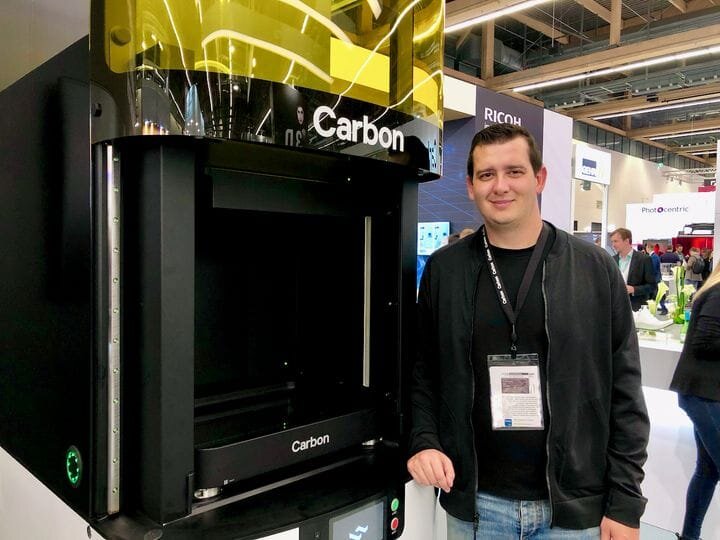![Carbon’s Philip DeSimone beside the Carbon L1 3D printer [Source: Fabbaloo]](https://fabbaloo.com/wp-content/uploads/2020/05/image-asset_img_5eb08cbfc9a3f.jpg)
We had a chat with Carbon’s Philip DeSimone at Formnext to learn how Carbon is pursuing business.
Carbon swept onto the 3D printing scene only a few years ago, charged up with a new method of rapid 3D printing resin they call “CLIP”. Since then the company has sold countless machines, mainly to the manufacturing industry and raised many hundreds of millions in investment.
It’s a huge technological and financial success, even as the story still plays out.
Carbon’s Secret Sauce
I’ve wondered what secret sauce Carbon uses to fuel their progress, and a discussion with DeSimone revealed some of their strategy.
Most 3D printer manufacturers seem to execute a simplistic marketing approach for their equipment: give the machine some fancy features and/or a cheap purchase cost and it will sell itself.
That approach is no longer effective, particularly in such a highly competitive 3D printing market. Carbon realizes this and seems to be doing something entirely different. Instead of focusing on the machine, they are instead focusing deeply on client applications.
While 3D print technology has been around for years, even before Carbon, few companies have properly leveraged it to create truly innovative products. It’s often a case of the client’s product concept not matching the client’s ability to design the product. That’s where Carbon steps in.
Manufacturing Innovative Products
DeSimone explained to us that Carbon typically speeds up the innovative process in companies, with a recent example of reducing what would have been a two-year product development project to only ten months. That’s significant in the competitive world of product design.
There’s another catch: even if a product can be designed and 3D printed once, it’s entirely insufficient. A product must be manufacturable, meaning it must be produced repeatedly and at higher volumes. And each item must pass quality control measures. DeSimone believes these are huge challenges for companies.
As such, Carbon spends considerable effort working on their hardware and software to increase yields, and designing systems and processes to handle higher part volumes. DeSimone said that “throughput is king”, and that in one case they’d been able to configure a solution for a client that was able to produce up to 35,000 units per year from a single Carbon 3D printer.
Carbon’s approach is to provide a consultative service to intervene at the early stages of a product development venture. While the client’s design staff may be unfamiliar with what is possible or how to go about designing advanced products, Carbon’s team can work with a client to tweak their proposed design to ensure it can be optimally produced with their equipment, or even help with the creation of a design from scratch with the client’s original concept.
Once this process is established for the client, machines are bought. Thus, the printers don’t sell themselves, instead the applications sell the printers.
Carbon Elastomeric Lattices
DeSimone explained Carbon’s sweet spot is to work with companies to design products using elastomeric lattices. These typically include products in what Carbon classifies as “Performance or Protection” applications, such as advanced athletic shoes or safety helmets.
One of the major barriers for companies, according to DeSimone, is the lack of an ability to do experiments in a factory setting. This is something that certainly must be done in order to introduce new manufacturing methods as Carbon’s. Factories exist to manufacture, not to mess around with.
To counteract this effect, Carbon has created a facility for clients to perform such experiments. With the help of Carbon’s consultative experts, a company could develop not only basic things like 3D printing parameters, but also operational procedures, material handling and more. When complete, it is possible to literally hand over a complete manufacturing process that could be quickly implemented at the client’s factory.
Committing To Innovative Products
This all makes a great deal of sense, but I wondered what happens at the earliest stage, where a company makes the decision to commit to an advanced product development. How can a company take that leap forward? Does it take a lot of convincing?
DeSimone agreed, saying it is challenging for companies to take the plunge into new designs they have not previously attempted. He said it’s even more challenging because inevitably a 3D printed product will be more expensive to produce than traditional products. They will “never be cheaper”.
The solution, according to DeSimone, is to design a product that actually solves an end-user problem by leveraging the capacities of 3D printing. By creating such a tuned product, the client can charge their clients more for a better product, and flow that money through to Carbon for the use of the equipment.
Carbon Subscription
DeSimone described another aspect that I had not considered. Unlike most other 3D printer manufacturers, Carbon offers their equipment as a multi-year subscription. Thus, when a client engages, they have the equipment onsite for a lengthy period. DeSimone says that the visible subscription payments force clients to have some “skin in the game” and thus encourages them to use the equipment more than otherwise might happen.
Carbon’s approach seems to be working. According to DeSimone, Carbon is currently working with a number of clients to develop all types of unusual advanced products. He says we should “expect to see cool things coming.”
We can’t wait!
Via Carbon

